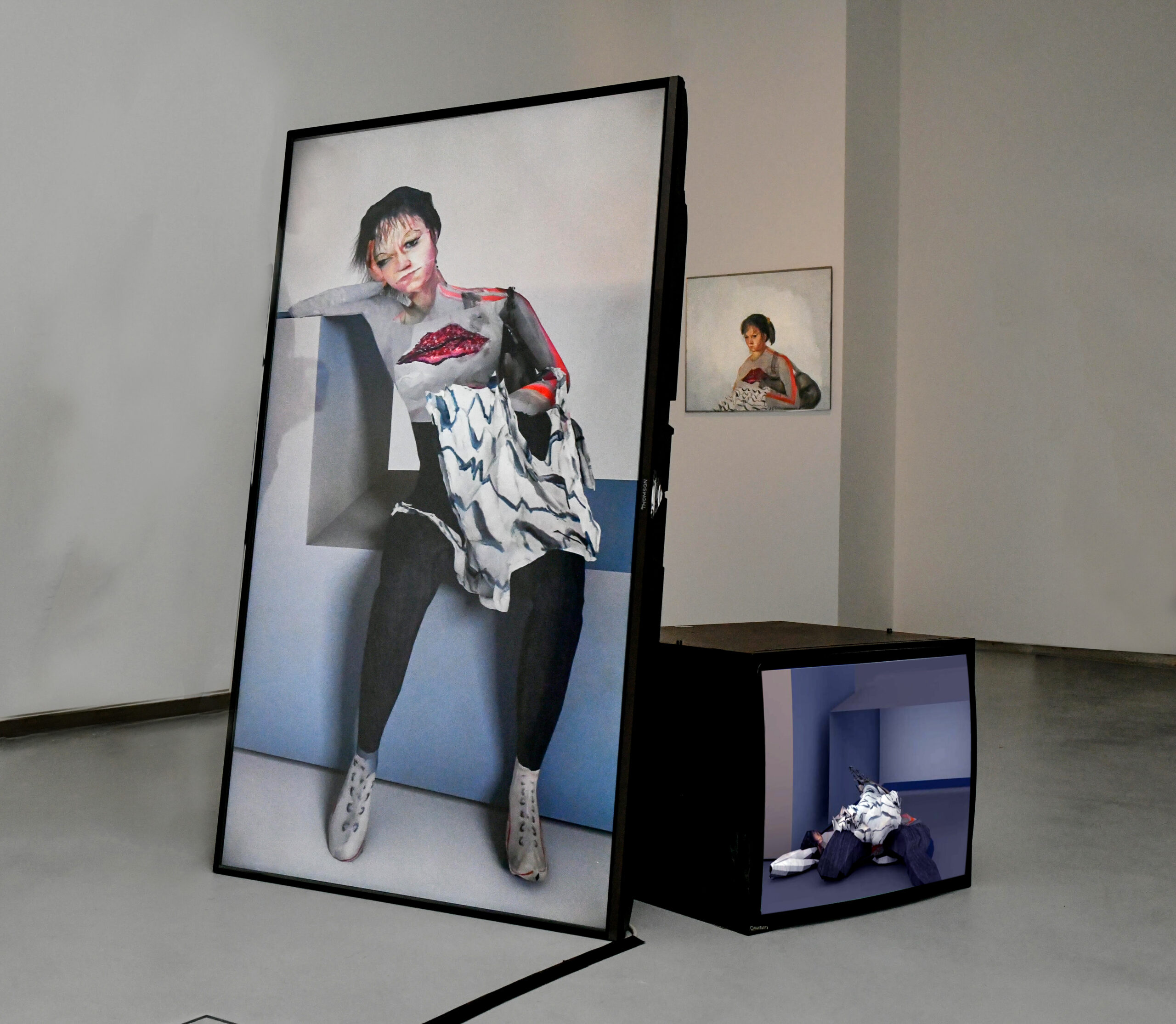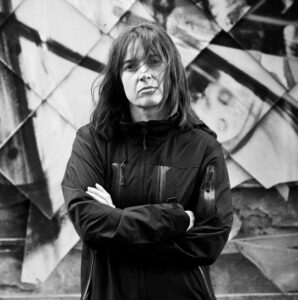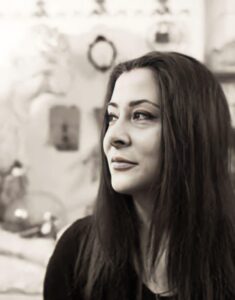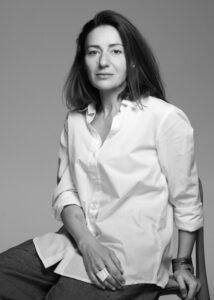Eszter Szabó
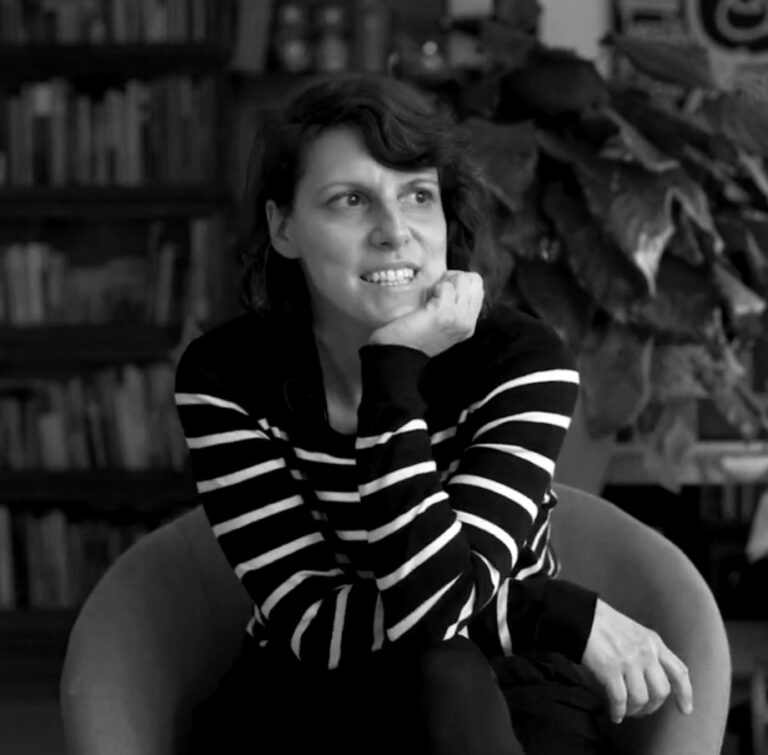
– b. 1979, based in Budapest. She took up painting at the Hungarian University of Fine Arts where she graduated in 2006. She completed her postgraduate studies at Le Fresnoy École Internationale des Arts Contemporains in 2016.
Her works are drawings, paintings and short, non-narrative, conceptual video loops, complemented with her recent interest in video installations and video sculptures. The videos are elaborated versions of her paintings, animated in 2D or in 3D or often with mixed techniques. She creates portraits of fictional but very familiar characters that she observes and ’collects’ in public spaces. When looking at people, instead of perceiving the extraordinary, her focus is directed on the ordinary, exposing otherwise unnoticed details and revealing invisible elements. Her protagonists are mostly Eastern European or Central European women, characterised by vulnerability, combatting aging, emotions and anger, fatigue of their everyday existence and many times, motherhood. Thus, these figures are a product of their geographical, political, historical and social context but the grotesque characters also possess a certain kind of humour that the artist depicts with a large amount of empathy and compassion.
Eszter Szabó showed her work at numerous solo shows and took part in various group exhibitions in Hungary, Paris, New York, Brussels among others. In 2021 she was the winner of the prestigious Leopold Bloom Art Award.
Methodology / concept
My work revolves around everyday people. I am observing people wearing T-shirts with hearts and glittering kissing mouths printed on them, those with frilly blouses and grown out hair, whose mouth is turning down and have make up over their puffy, tired eyes. I am interested in the floral patterns inconveniently warping and disappearing in and out of body folds. I am also inspired by the inert or irritated postures I can relate with.
My watercolor and oil paintings are made quickly on thin material, and are slightly translucent. My animations deal with details that happen in seconds. In my animations, I am dealing with the seconds, the small details. All my works are a combination of both generalization and non-judgmental observation as well as mixing blurred half-truths with razor-sharp details.
I created a certain perceptual practice in which, instead of perceiving the extraordinary I direct my focus on the ordinary. By recognizing notions of familiarity, some invisible perspectives are getting revealed. I am interested in social mechanisms and the boundaries between the personal and the political. I am intrigued by the desire for beauty and harmony, and by the expectations towards women. Recently I started inventing female characters that are inspired by everyday women I observe on the streets or in the corridors of the kindergarten. I try to formulate these portraits in such a way that they are free of ideas deeply attached to the notion of “femininity”. I am interested in whether it is possible to push the boundaries of imagination in the portrayal of women.
About animation
Animation plays a significant role in my works. The idea of creating an animation came to me while playing with a piece of wax in my old studio at the University. My first video titled Shapes1 was about the desire for assimilation and perfection and about the distortions during the attempt at getting into the right shape. Instead of creating a narrated story, I became interested in showing content through movement, while I am building a non-traditional narrative. I consider my videos as extended versions of my paintings and I install them accordingly. I usually display them on screens installed on the wall or in the space, or as projection. Importantly, the viewer can start and stop watching the video loops at any time.
Selected works In my earlier works, I created a series of watercolors and short animations about people wandering around in everyday life (C’est combien le kilo?)2. I continued this series with speculations about the future (in 2053)3. My video work Maria4 is dealing with the relationship between the image and moving image, and between the artist, the image and the viewer. It is an attempt to create a detailed portrait of a fictional, but average woman. The final work turned out to be much more grotesque than planned, so the character begins to “talk back”, criticizing the artwork, complaining to the creator and the viewer.
I created The Reconquest of Paradise5 in 2011, the year when the political situation that defines our life until this day started to escalate in Hungary. The work is an ironic formulation of an idyllic state, a draft of an “ideal” future. The video was inspired by the final scene of the 1986 Hungarian animated film, Cat City (director: Béla Ternovszky), in which the method of defeating the enemy is to make them dumb, to tame them. The three minutes long video includes a number of nationalist symbols, such as the happy, folk dancing couple leaving the local supermarket, the fountain shaped like the Holy Crown of Hungary or the traditional greeting, in which men kiss women’s hands.
The “Sublime beauty” embodied in decoration was in my focus while creating my series of paintings and videos entitled Dispenser of Delights6. I painted the imaginary tenants on photos of downloaded real estate advertisements from the Internet. I reimagined the spaces in 3D and animated the ritual activities of the presumed residents using mixed media.
Abandoning the Testicals7 deals with the political questions of gender in a more direct form, and addresses the burdens and anger of women.
Homo Domesticus8 seeks the aforementioned forms of representing women and methods of domestication. As part of this project, I started to use reproductions of 15th-16th century paintings: I transformed the details of facial expressions from these old images into my present work.
My video Princess Beauty9, produced between 2020 and 2022, and the video installation that evolved from it, were inspired by a sulking female character in a Lucas Cranach portrait. I transposed Anna Cuspinian’s bored, defiant gaze into a contemporary medium. I painted a modern-day character wearing a ponytail, make-up and a top with a glittery mouth printed on it (A.C.). I used this painting as the texture for the 3D animation based on a tale entitled Beautiful Princess by Aliz Mosonyi. In the tale, a girl is bored by the overwhelming discipline of two tulips. In the video, the power of the invisible tulips is shown in the form of physical simulations generated by the software. The animation of the protagonist’s own movements and the machine-calculated simulations got tangled up in the process, creating random glitches around the character. I created the final video using these fragments. The latest presentation of this work is a walk-around video installation, a sculpture-like pile of screens.
In my most recent works that are still in progress, I am experimenting with simulations as motifs of burdens, expectations and situations generated by life. While exploring different layers of reality, I also started working with augmented reality applications.
Feminism and “women’s art”
I do not use the phrase “women’s art”. I find it confusing, because it reinforces the very phenomenon that everything has a default male perspective, which defines and distinguishes “women’s art” from art itself. It is also unclear whether we are talking about art that deals with the situation of women, or art produced by women, or about the intersection of these two.
I am interested in women’s self-image. I started to deal with this topic at the University of Fine Arts. I tried to convince the secretarial staff to let me paint a portrait of them, as these two women were very important characters in the university’s everyday life. At first they didn’t like the idea at all, suggesting that I should find a ‘nicer’ theme and fearing that they would be the subject of some kind of mockery. These concerns do not qualify them. According to the generally established social norms, Mrs Pongó and Mrs Ollós are clearly not meant to be portrayed by an artist.
From the current circumstances of women, I am interested in the state of fatigue and exhaustion, the struggle between impossible and conflicting expectations.
The statement was written in collaboration with arts historian Kata Balázs (2022).
1Image: Eszter Szabó, Shapes, 2006, 3 channel DV video, 1’. Courtesy of the artist.2Image: Eszter Szabó, C’est Combien le Kilo?, 2008-2010, series of small size aquarelles on latex and short videos, 10-30”. Courtesy of the artist.
3Image: Eszter Szabó, In 2053, 2010, 5 channel HD video, 8’. Courtesy of the artist.
4Image: Eszter Szabó, Maria, 2010, video still, HD video, 57”. Courtesy of the artist.
5Image: Eszter Szabó, The Reconquest of Paradise, 2011, video still, HD video, 3’. Courtesy of the artist.
6Image: Eszter Szabó, Dispenser of Delights, 2014-2015, video still, 4K video, 4’30”. Courtesy of the artist.
7Image: Eszter Szabó, Abandoning The Testicles, 2017, video still, HD video, 1’19”. Courtesy of the artist.
8Image: Eszter Szabó, << A Woman>>, 2019, oil on paper and wood, 40x25 cm. Courtesy of the artist.
9Image: Eszter Szabó, Princess Beauty, 2021, Hantarex TVs, LED TV, oil painting (oil on paper and wood, 76cm x 67cm), A4 print of Lucas Cranach’s Anna Cuspinian. Installation view, courtesy of the artist.
– szül. 1979, Budapesten él. A Magyar Képzőművészeti Egyetemen festészeti tanszéken szerzett diplomát 2006-ban, majd A Le Fresnoy École Internationale des Arts Contemporains-ben végezte posztgraduális tanulmányait 2016-ban. Munkásságában központi szerepet kapnak a rajzok, festmények és rövid, nem-narratív animációk. Az utóbbi években ezek egyvelegéből szoborszerű videoinstallációkat épít. A videók festményeinek tovább gondolt változatai, 2D-ben illetve 3D-ben, illetve legtöbbször kevert technikákkal meganimálva.
Munkáiban visszatérő téma a fiktív, de ismerős vonásokkal rendelkező portré témája, amelyekhez az utcán gyűjt inspirációt. Munkamódszerében a megszokottságukban láthatatlanná vált elemekre fókuszál. Főhősei többnyire fáradt, esendő, dühös, öregedő kelet- közép európai nők. Sajátos, a rájuk jellemző földrajzi, politikai és szociális kontextusban létező figurák. A művész a már-már groteszk, vicces karaktereket ugyanakkor nagy szeretettel, és empátiával fogalmazza meg.
Szabó Eszter munkái számos egyéni és csoportos kiállításon vettek részt Magyarországon kívül, többek között, Párizsban, New Yorkban, Brüsszelben, stb. 2021-ben elnyerte a Leopold Bloom Art Award díjat.
Módszer / koncepció
Hétköznapi emberekkel foglalkozom. Azokat az embereket figyelem, akik szívecskés, csókos szájas-flitteres pólót, fodros blúzt hordanak, le van nőve a hajuk, szájuk lefele görbül, karikás szemük kifestett. Érdekel, ahogy a virágos vagy csíkos minta kényelmetlenül fordul és eltűnik. A tespedt vagy irritált testtartások, amikben magamra ismerek.
Akvarelljeim és olajképeim vékony anyagra, lazúrosan, gyorsan készülnek. Érdekel a pillanatnyiság. Animációimban a másodpercekkel, a részletekkel foglalkozom. Festményeim és videóim az általánosítás és az ítélkezésmentes megfigyelés, az összemosás és a penge részletek elegyei.
A létrejött munkák egyfajta szemlélődési gyakorlat eredményei, melyben figyelmemet a sokszor látott, ismerős jelenségekre irányítom. A ráismerés érzésén keresztül foglalkozom a láthatatlan láttatásával.
Érdekelnek a társadalmi folyamatok lenyomatai, a személyes és a politikus/politikai határmezsgyéje. A „szépség” fogalma, a „harmónia” utáni vágyakozás, illetve az embereket – különösen a nőket – sújtó elvárások. Az utóbbi években a munkáim fiktív női karakterekből táplálkoznak, amiket az utcán vagy az óvodafolyosón látott elemekből gyúrok össze. Ezeket a portrékat úgy próbálom megfogalmazni, hogy mentesek legyenek a „nőiesség” fogalmához mélyen rögzült ideáktól. Az érdekel, hogy lehet-e tágítani a képzelet határait a nők ábrázolásában.
Az animálásról
Munkáimban fontos az animáció szerepe. Az egyetemi műteremben, egy viaszkockát gyúrogatva jött az ötlet, hogy pl. az ember örökös vágyát az idomulásra, a tökéletességre és az eközben keletkezett torzulásokat mozgóképes formában fogalmazzam meg (Idomok)1. Egyre inkább érdekelni kezdett, hogy egy elbeszélt történet gyártása helyett mozdulatokon, jelenségeket keresztül milyen tartalmak jeleníthetők meg, miközben nem hagyományos narratívát építek fel.
Videóimra, melyek átlagosan maximum 1 perc hosszúak, leginkább mint egyfajta kiterjesztett festészetre tekintek. Ennek megfelelően többnyire festmény-szerűen, falon vagy a térben installált képernyőkön, vagy projektorral vetítve állítom ki őket. Fontos, hogy a néző bármikor elkezdheti és befejezheti az újra és újra induló videó loopok nézését.
Fontosabb munkák
Korai munkáimban a mindennapokban bolyongó emberekről készítettem akvarell és animáció sorozatot (C’est combien le kilo?)2. Ezt később a jövővel kapcsolatos spekulációkkal folytattam (in 2053)3.
A kép és a mozgókép, illetve az alkotó, a kép és a néző viszonyával foglalkozik a Mária4 című videómunkám, amely kísérlet egy hiteles, részletes portré elkészítésére egy kitalált, de átlagos nőről. A végeredmény a tervhez képest jóval groteszkebb lett, így alakult, hogy az ábrázolt figura elkezd „visszabeszélni”, kritizálja az elkészült művet az őt létrehozó alkotónak és a nézőnek reklamálva.
A Paradicsom visszahódítása5 című munkám 2011-ben készült, tehát akkor, amikor Magyarországon elszabadult az a politikai téboly, ami azóta is meghatározza a mindennapokat. Ez egy idill ironikus megfogalmazása; egy „ideális” jövőkép felvázolása. A 3 perces videóban sok a nacionalista referencia, a helyi CBA-ból kirobbanó örömmel, néptáncolva távozó szerelmespártól a magyar Szent Korona formában csobogó szökőkúton át, a hagyományőrző kézcsókokig. A videót a Macskafogó című 1986-os rajzfilm (rendezte: Ternovszky Béla) utolsó jelenete inspirálta, melyben az ellenfél végső legyőzésének módszere annak teljes lebutításával, bárgyúvá szelídítésével történik.
A dekorációkban megtestesülő „fennkölt szépség” érdekelt a Gyönyörűségek6 című festmény sorozatom és videóm létrehozásakor. Internetről letöltött lakáshirdetések fotóira festettem meg az elképzelt lakókat. A tereket 3D-ben tovább gondoltam és a megfestett lakosok rituális tevékenységeit pedig kevert technikákkal animáltam meg.
Közvetlenebbül foglalkozik politikummal, vagyis a társadalmi nem kérdéseivel A here elhagyása7 című videómunkám is, ami a nők terheit és dühét tematizálja.
A Homo Domesticus8 című sorozat képei a már korábban is említett szelídítési folyamatokat, illetve a nők reprezentációjának formáit keresi. Ennek keretében kezdtem el olyan 15-16. századi festmények repróit felhasználni, melyeken az arckifejezések részleteit át tudom telepíteni a jelenbe.
A 2020 és 2022 között készült Széphercegnő9 című videómat és az ebből továbbfejlesztett videóinstallációmat is egy Lucas Cranach portrén látott duzzogás inspirálta. Anna Cuspinian unott, méltatlankodó tekintetét emeltem át egy kortárs közegbe, köré festve egy mai karaktert, csillogós szájas felsőben, lófarokban, kisminkelve (A.C.). Ezt a festményt használtam fel a 3D animációhoz is, mely Mosonyi Aliz Széphercegnő című meseversén alapszik. A versben egy lányt két tulipán untat hatalmaskodó nevelésével. A videóban a láthatatlan tulipánok ereje, a szoftver által generált fizikai szimulációk formájában jelenik meg. A főhős saját mozdulatainak animációja és a gép által kiszámolt szimulációk a munkafolyamat során összegabalyodtak, véletlenszerű glitch-ek keletkeztek a figura körül és főszereplésével. A videót ezeknek a fragmentumoknak a felhasználásával készítettem el. A munka legújabb megjelenítési formája egy körbejárható videóinstalláció, egy szoborszerű képernyőhalom.
Legfrissebb, még alakuló munkáimban tovább kísérletezem szimulációkkal, mint az élet által generált helyzetek, elvárások, terhek motívumaival. A valóság különféle rétegeinek feltárásával foglalkozva elkezdtem dolgozni különféle kiterjesztett valóság-applikációkkal is.
Feminizmus és „nőművészet”
Nem használom a „nőművészet” szót. Zavarosnak tartom, mert pontosan azt a jelenséget erősíti, hogy mindenen ott ül az alap („default”) férfi szemszög, ami kijelöli, megkülönbözteti magától a „nőművészetet”. Az sem tisztázott sokszor, hogy a nők helyzetével foglalkozó, vagy a nők által gyártott művészetről beszélünk-e, vagy csak a kettő közös metszetéről. Érdekel a nők önmagukról alkotott képe. Még a Képzőművészeti Egyetemen kezdtem el ezzel foglalkozni, mikor megpróbáltam a titkárság munkatársait arról meggyőzni, hogy hadd fessek róluk egy portrét, mivel a két nő nagyon karakteres szereplője volt az egyetemi hétköznapoknak. Az ötlet eleinte egyáltalán nem tetszett nekik, azt javasolták, hogy keressek „szebb” témát, illetve attól tartottak, hogy valamiféle gúnykép fog születni róluk. Ezek az aggodalmak nem őket minősítik. Az általánosan kialakul társadalmi normák szerint Pongóné és Ollósné figurája nyilvánvalóan nem kívánkozik ecsetvégre (Pongóné és Ollós Ani).
A nők aktuális körülményeit illetően engem mostanában leginkább a fáradság, a kimerültség állapota érdekel, a vergődés a lehetetlen és egymásnak ellentmondó elvárások között.
A statement a művész és Balázs Kata művészettörténész közreműködésében jött létre (2022).
1Kép: Szabó Eszter, Idomok, 2006, 3 csatornás DV videó, 1’. A művész jóvoltából.2Kép: Szabó Eszter, Mennyibe kerül kilója, 2008-2010, kisméretű akvarellek latexen és rövid videók, 10-30”. A művész jóvoltából.
3Kép: Szabó Eszter, In 2053, 2010, 5 csatornás HD videó, 8’. A művész jóvoltából.
4Kép: Szabó Eszter, Mária, 2010, HD videó, 57”. A művész jóvoltából.
5Kép: Szabó Eszter, A Paradicsom visszahódítása, 2011, HD videó, 3’. A művész jóvoltából.
6Kép: Szabó Eszter, Gyönyörűségek, 2014-2015, 4K videó, 4’30”. A művész jóvoltából.
7Kép: Szabó Eszter, A here elhagyása, 2017, HD videó, 1’19”. A művész jóvoltából.
8Kép: Szabó Eszter, << Egy nő >>, 2019, olaj, papír, falap, 40 cm x 25 cm. A művész jóvoltából.
9Kép: Szabó Eszter, Széphercegnő, 2021, Hantarex TV, LED TV, olajkép (olaj falapon és papíron, 76x67 cm), A4-es print Lucas Cranach Anna Cuspinian c. képéről. Enteriőr kép, a művész jóvoltából.
